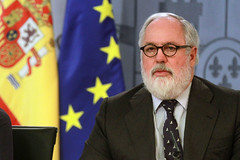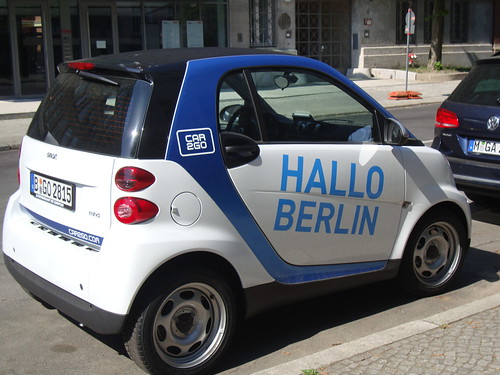 歐盟氣候行動與能源委員的Miguel Arias Cañete近期在金屬業工會(IG Metall)大會中表示,「有些人認為最近石油降價將對電動車有負面影響,而我個人相信不會是這種情況。」
歐盟氣候行動與能源委員的Miguel Arias Cañete近期在金屬業工會(IG Metall)大會中表示,「有些人認為最近石油降價將對電動車有負面影響,而我個人相信不會是這種情況。」
這場名為「對於汽車業二氧化碳排放程度監控的要求」(“Demands with regard to regulation of CO2 levels for the automotive industry”)的會議由代表汽車產業藍領與白領階級的德國金屬業工會舉辦。
碳排自我監控 汽車業者籲技術中立
Arias告訴與會代表:「這是為何在未來監控的設計上,我們打算採取一個技術中立的做法,製造業者必須能自行選擇最符合成本效益的方式來達成排放目標。」
Arias說,「新的目標將激發創新和投資。不過在適時且勝利的科技上,我們還沒有明確的觀點,例如,電汽股份(shares of electric)、插電式混合動力系統(plug-in-hybrid)或氫氣電車(hydrogen vehicles)將如何發展。」
2011年至2014年擔任西班牙農業食品與環境部部長的Arias,曾為西班牙中間偏右翼政黨西班牙人民黨(Partido Popular)黨員,也曾經是Ducor SL和Petrologis Canarias SL兩家石化公司的前董事,雖然據說他已賣出自己的持股,但仍收到環保人士集結50萬人簽名的請願書,反對他在去年秋季出任氣候與能源委員。
保障就業 金屬業也願意減碳
在歐洲執委會和汽車業者之間對碳排放限制的爭執中,金屬業工會自居為中間協調者。金屬業工會第一任會長Detlef Wetzel表示,「在氣候政策上我們想要向前邁進,但我們也想要確保就業受到保障。」
針對市場朝向電動車的結構性變化,Wetzel要求對汽車產業的進行就業影響評估。
他說,在這個情況下,二氧化碳排放限值的修訂可能最快要到2017年,唯有在那之後才能看出市場上如何接受電動車,及電動車對二氧化碳減量如何做出貢獻。
「目前電動車的需求明顯低於預期。不曉得什麼時候電動交通會盛行,」Wetzel說,德國有14,000輛登記的電動汽車,不過只有大部分車輛製造業者藉著電力驅動能夠達成這個二氧化碳減量的目標。
「因此為了支持調控中的電動汽車,金屬業工會要求有效的激勵措施。電力驅動必須像先前一樣包含在車隊平均燃油經濟性(fleet average fuel economy)的計算當中,具有二氧化碳零克排放水平。」Wetzel說。
歐盟:2030年交通部門必須減碳4成
去年10月,Arias提醒金屬業工會的成員,歐盟的領導者公布一項直至2030年的新氣候和能源政策框架,其中最重要的部分就是一項約束性目標,溫室氣體排放必須比1990年減量至少40%。
「這表示交通部門需要加緊減碳的腳步。歐盟需要減低排放及對進口汽油和燃料的依賴,而且交通部份需要扮演它的角色,」委員說。
「這是為何歐盟領導者命令委員會調查,2020年之後我們可以使用的措施與辦法,以更進一步地降低排放、提升能源效率,及發展電力交通的使用與交通方面的可在生能源。」委員說。
「我們長期的目標是在2050年以前減少交通排放量60%。這在4年前的交通白皮書中已載明,並在我們對2030年框架的溝通中再次重申。」Arias說,「我們知道為了達成這個目標,2020年之後我們必須加強努力。」
Arias解釋,歐盟委員會總裁Jean-Claude Juncker已經承諾讓歐洲恢復成長。「強化我們的經濟的同時,也需要讓它更加節能及氣候智慧型。這是為何建立具有前瞻性氣候改變政策的彈性歐盟是Juncker帶領的委員會首要任務之一。」
碳排如何測量? 數據正確才有助立法
Arias說,委員會將於25日向歐盟提供策略性的框架概述,並於今年後續提交立法建議,以實現歐盟2030年的氣候和節能政策框架。
但委員解釋,因為實驗室量測的結果與駕駛的經驗並不符合,可能會阻礙二氧化碳立法的成功。「我們的監控在實際運作時必須有效。」,他說。「人為數據傷害環境與氣候、誤導消費者,及對賦稅收入產生扭曲性的影響。」
所以委員會正努力發展一項全球一致的二氧化碳測試程序,起草Arias說過今年初即將就緒的立法。「歐洲議會、歐盟委員會及會員國明確承諾與此前進,且在2017年9月實施新的測試循環。」,Arias說,請求與會代表支持這項新的二氧化碳測試程序。
最後,他說雖然如卡車、公車及客車這些重型車輛約占歐洲道路交通所有二氧化碳排放1/4,但現今這些排放既沒有測量也沒有呈報。
「在我們去年5月被採納的重型車輛策略中,首度凸顯出知識上的差距。現在,工作正在進行完成模擬工具VECTO,以測定這些車輛的二氧化碳排放量。」,Arias說。「為了證明及監測排放,我們也正設法說服兩件立法。我們的目標是在2016年初讓這些就緒。」
“Some people think that the recent decrease in oil prices will have a negative impact on electric cars. Personally, I am convinced that this will not be the case,” said Miguel Arias Cañete, EU commissioner for climate action and energy, in a speech at the IG Metall conference on Tuesday.
The conference, titled, “Demands with regard to regulation of CO2 levels for the automotive industry,” was organized by IG Metall, the Industrial Union of Metalworkers. The dominant metalworkers’ union in Germany, it represents both blue-collar and white-collar workers in the automotive industry.
“New targets will trigger innovation and investments,” said Arias, “but we do not yet have a clear view on the timing and the winning technologies, for example how the shares of electric, plug-in-hybrid or hydrogen vehicles will develop.”
“That is why, in the design of future regulation, we are taking a technology neutral approach. Manufacturers must be able to choose the most cost-effective ways to meet emission targets,” he told conference delegates.
A member of the center-right Spanish political party Partido Popular, Arias served as Minister for Agriculture, Food and Environment in the Spanish Government from 2011 until 2014. He was a former director of two oil companies, Ducor SL and Petrologis Canarias SL, whose shares he reportedly sold just before his confirmation as climate and energy commissioner last fall.
Opposed by environmentalists, who gathered half a million signatures on a petition against his confirmation, Cañete must also prove himself to the automotive workers union.
In the dispute over emissions limits between the European Commission and the auto industry, IG Metall sees itself in a mediating role. “We want to move forward in climate policy, but we also want to ensure that employment is secured,” Detlef Wetzel, first president of IG Metall, said at the conference.
Wetzel called for an impact assessment on the effects of structural change towards an electric drive on employment in the automotive industry.
A revision of the carbon dioxide limit value is possible in this context in 2017 at the earliest, he said. Only then can it be seen how well electric cars will be accepted on the market and how much they can contribute towards CO2 reduction.
“Currently, the demand for electric cars is significantly behind expectations. It is unclear when emobility will prevail,” Wetzel said.
There are 14,000 registered electric vehicles in Germany, he said, yet the goals of CO2 reduction are only attainable for most car manufacturers by electric drives.
“Therefore, the IG Metall demands effective incentives in favor of electric mobility in the regulation. Electric driving must be included in the calculation of the fleet averages as before with a CO2 emission level of zero grams,” Wetzel said.
“I understand the challenge for industry. Companies must take strategic long-term investment decisions, and their staff will be impacted as well,” said Commissioner Arias. “Effective retraining will be important to ensure competitiveness and social equity. In this context, IG Metall will play an instrumental role.”
Last October, Arias reminded the IG Metall audience, EU leaders endorsed a new climate and energy policy framework for the period up to 2030. One of its cornerstones is a binding target to reduce EU greenhouse gas emissions by at least 40 percent compared to 1990 levels.
This means that the transport sector has “to keep up – and step up – the pace of decarbonization. Europe needs to cut its emissions and reduce its dependency on imported gas and fuel, and transport needs to play its part,” said the commissioner.
“That is why EU leaders mandated the Commission to look into measures and instruments we can use after 2020 to further reduce emissions, increase energy efficiency, and develop the use of electric transport and renewable energy in the transport sector,” he said.
“Our long-term goal is to reduce transport emissions by 60 percent by 2050. This was set out in the Commission’s Transport White Paper four years ago and reiterated in our communication on the 2030 framework,” Arias said. “We know that to meet this goal we have to intensify our efforts after 2020.”
Arias explained that EU Commission President Jean-Claude Juncker has made a commitment to get Europe growing again. “Making our economy stronger also requires making it more energy- and climate-smart. That is why building a resilient Energy Union with a forward-looking climate change policy is one of the top priorities of the Juncker Commission.”
On February 25, the Commission will outline the strategic framework for the Energy Union. On the same day, the commissioners will adopt another communication on “The road to Paris” that will set out the EU vision and expectations in the run-up to the international climate negotiations in Paris in December,” he said.
Later on this year, Arias said, the Commission will start to table legislative proposals to implement the EU’s climate and energy policy framework for 2030.
But the success of CO2 legislation risks being undermined by the fact that the results measured in the laboratory do not correspond to what drivers are experiencing, the commissioner explained.
“Our regulations have to be effective ‘when the rubber meets the road,'” he said. “Artificial values harm the environment and climate, mislead consumers and have a distorting impact on tax revenues.”
So the Commission is working on developing a new worldwide harmonized CO2 test procedure, drafting legislation that Arias said will be ready early this year.
“There is a clear commitment by the European Parliament, the Commission and Member States to go forward with this and have the new test cycle applicable from September 2017,” said Arias, asking the delegates for their support of the new CO2 test procedure.
Finally, he said that while heavy-duty vehicles such as trucks, buses and coaches are responsible for about a quarter of all CO2 emissions from road transport in the EU, today these emissions are neither measured nor reported.
“We highlighted this knowledge gap for the first time in our strategy on heavy duty vehicles adopted in May last year. Now, work is in progress to finalize the “VECTO” simulation tool to determine CO2 emissions from these vehicles,” said Arias. “We are also working on two pieces of legislation to certify and monitor emissions. Our aim is to have all of this ready by early 2016.”
※ 全文及圖片詳見:ENS






